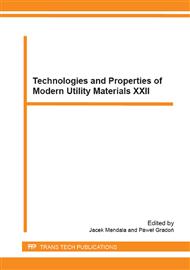p.99
p.103
p.107
p.111
p.115
p.121
p.127
p.133
p.137
Porosity of Solid and Cored Turbine Blades of Aircraft Engines
Abstract:
Paper presents results of quantitative evaluation of porosity conducted on big, thin walled airfoil turbine blades made from Inconel 713C alloy. To decrease mass, blades are design and manufacture like thin walled cored castings. Manufacturing of big thin walled casting airfoil blades is extremely difficult. During exploitation casting work undergo cycle fatigue. In that cause casting should be free of casting defects, including porosity. Conducted research focused on Inconel 713C superalloy pouring temperature effect on porosity level of cored casted turbine blade. Results were compared to porosity of solid casted turbine blade. It was found that porosity of cored blades is lower than solid blade porosity. In cored blades higher porosity is located on airfoil convex side. Airfoil concave side has lower porosity.
Info:
Periodical:
Pages:
115-118
Citation:
Online since:
January 2015
Authors:
Keywords:
Price:
Сopyright:
© 2015 Trans Tech Publications Ltd. All Rights Reserved
Share:
Citation:


